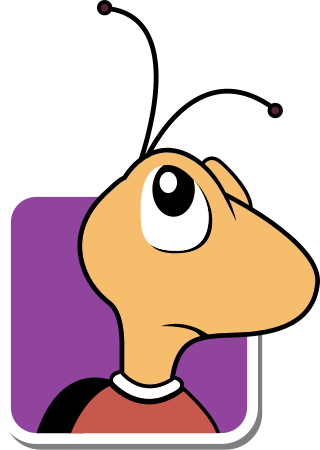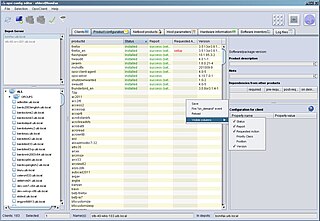
Bugzilla is a web-based general-purpose bug tracking system and testing tool originally developed and used by the Mozilla project, and licensed under the Mozilla Public License.

Configuration management (CM) is a management process for establishing and maintaining consistency of a product's performance, functional, and physical attributes with its requirements, design, and operational information throughout its life. The CM process is widely used by military engineering organizations to manage changes throughout the system lifecycle of complex systems, such as weapon systems, military vehicles, and information systems. Outside the military, the CM process is also used with IT service management as defined by ITIL, and with other domain models in the civil engineering and other industrial engineering segments such as roads, bridges, canals, dams, and buildings.
Information technology service management (ITSM) are the activities performed by an organization to design, build, deliver, operate and control IT services offered to customers.
A configuration management database (CMDB) is an ITIL term for a database used by an organization to store information about hardware and software assets. It is useful to break down configuration items into logical layers. This database acts as a data warehouse for the organization and also stores information regarding the relationships among its assets. The CMDB provides a means of understanding the organization's critical assets and their relationships, such as information systems, upstream sources or dependencies of assets, and the downstream targets of assets.
Notable issue tracking systems, including bug tracking systems, help desk and service desk issue tracking systems, as well as asset management systems, include the following. The comparison includes client-server application, distributed and hosted systems.
Software asset management (SAM) is a business practice that involves managing and optimizing the purchase, deployment, maintenance, utilization, and disposal of software applications within an organization. According to ITIL, SAM is defined as “…all of the infrastructure and processes necessary for the effective management, control, and protection of the software assets…throughout all stages of their lifecycle.” Fundamentally intended to be part of an organization's information technology business strategy, the goals of SAM are to reduce information technology (IT) costs and limit business and legal risk related to the ownership and use of software, while maximizing IT responsiveness and end-user productivity. SAM is particularly important for large corporations regarding redistribution of licenses and managing legal risks associated with software ownership and expiration. SAM technologies track license expiration, thus allowing the company to function ethically and within software compliance regulations. This can be important for both eliminating legal costs associated with license agreement violations and as part of a company's reputation management strategy. Both are important forms of risk management and are critical for large corporations' long-term business strategies.
This is a comparison of notable free and open-source configuration management software, suitable for tasks like server configuration, orchestration and infrastructure as code typically performed by a system administrator.

HEC Liège Management School - University of Liège is the college and graduate school of the University of Liège in the fields of economics, finance, business administration, entrepreneurship and engineering management.
Open Computer and Software Inventory Next Generation is free software that enables users to inventory IT assets. OCS-NG collects information about the hardware and software of networked machines running the OCS client program. OCS can visualize the inventory through a web interface. Furthermore, OCS includes the capability of deploying applications on computers according to search criteria. Agent-side IpDiscover makes it possible to discover the entirety of networked computers and devices.
The Les Trophées du Libre contest was a free software contest whose goal was to promote innovative software projects by giving those projects recognition and media coverage and rewarding participating students and academic institutions with special prizes.
fraLine is a non-profit (research) project of Research Center Frankfurt Technology Center Media - FTzM of Frankfurt University of Applied Sciences. Project and research activities focus on IT services management for schools and the use of digital media in educational settings. fraLine is also a joint project between the Frankfurt University of Applied Sciences and the city of Frankfurt am Main. fraLine and the city of Frankfurt cooperate in the fields of IT support and IT service management in educational contexts as well as technical implementation of digital media in class. fraLine also cooperates with the Hessian state education authority in the field of media education and digital media training for teachers. fraLine was launched in 2001 by Professor Dr Thomas Knaus and employs mainly technical students of the Frankfurt University of Applied Sciences and Goethe University Frankfurt, but also IT professionals, engineers and media educators.

Opsi is a software distribution and management system for Microsoft Windows clients, based on Linux servers. Opsi is developed and maintained by uib GmbH from Mainz, Germany. The main parts of Opsi are open-source licensed under the GNU Affero General Public License.

Supportworks is an issue tracking system designed for use in help desk and information technology (IT) environments. Two branches of the software are developed concurrently, Supportworks ITSM, a certified ITIL compatible IT service management (ITSM) solution, and Supportworks Helpdesk Professional.

ZENworks, a suite of software products developed and maintained by OpenText for computer systems management, aims to manage the entire life cycle of servers, of desktop PCs, of laptops, and of handheld devices such as Android and iOS mobile phones and tablets. As of 2011 Novell planned to include Full Disk Encryption (FDE) functionality within ZENworks. ZENworks supports multiple server platforms and multiple directory services.
Micro Focus Service Manager is one of the applications acquired by Micro Focus when it purchased part of Hewlett-Packard Enterprise Software (HPES) in 2017. Before 2017, it was owned by HP when it purchased Peregrine Systems in 2005. The application was originally known as PNMS. After releasing the first version of PNMS, Peregrine Systems eventually added functionality such as Request Management, Call Management, and Change Management and rebranded the application as Peregrine ServiceCenter.
Omnitracker is a proprietary business process platform developed by Omninet GmbH in Germany. Omnitracker is developed as modular software for medium and large companies. It is used to track, control and evaluate relevant business processes. The main area of application is the support of ITIL compliant processes, which manages requests, incidents/ errors, customer inquiries from the moment of creation to completion. Omnitracker received certifications of the Federal Association of IT-Mittelstand and Pink Elephant that covers nine processes.
Samanage, now part of SolarWinds, an enterprise service-desk and IT asset-management provider, had its headquarters in Cary, North Carolina. The company's flagship product, Samanage, operates as a multi-tenant, Software-as-a-Service (SaaS) system for IT and enterprise service management. As of November 2018, Samanage had more than 1,800 customers in 50+ countries.
Absolute Software Corporation is an American-Canadian company that provides products and services in the fields of endpoint security and zero trust security. It was publicly traded company on the Toronto Stock Exchange (TSX) and Nasdaq until it was acquired by Crosspoint Capital Partners in July 2023.
Uhuru Mobile is a secure Android-based operating system.
Data center management is the collection of tasks performed by those responsible for managing ongoing operation of a data center. This includes Business service management and planning for the future.







